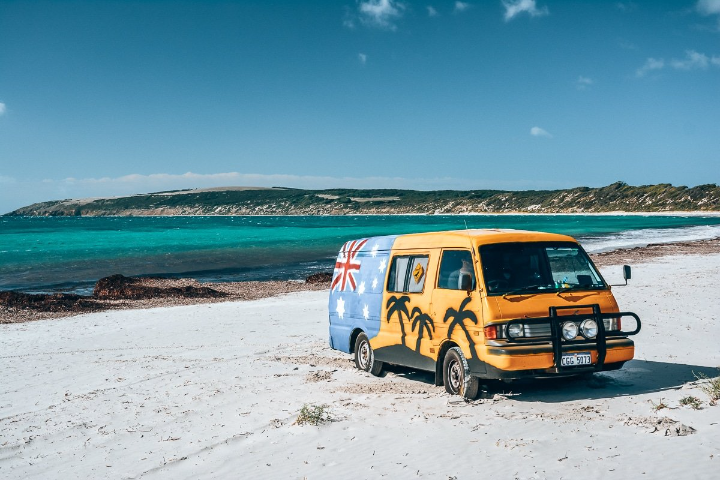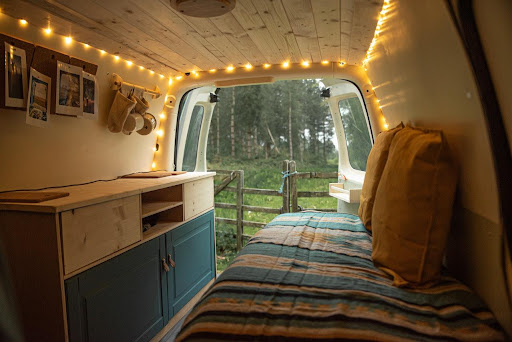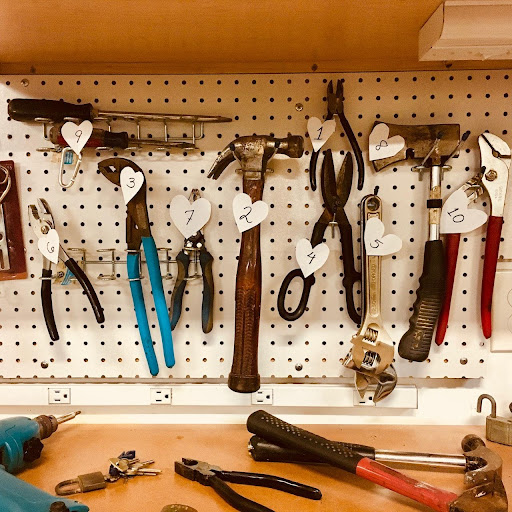Van Life: How To Convert Your Van

With the rise of nomadic lifestyles and travelling in general, using your car as a home has become increasingly popular. Nowadays, more and more people value the freedom and flexibility of being on the move.
We travel more than ever before, and as a result,
we also question things that used to be seen as the only option; home isn’t
always confined by four walls and a set location anymore. Home is wherever your
heart is, and for travellers, home could be where your van is parked.
However, building a home, whether a house or a van,
takes time, money, and energy. This article is here to help you get started on
your van conversion. We will go through, step by step, what you need to think
about when you convert your van.
Getting Started with Van Life
There are multiple reasons why people choose to change out their homes for a vehicle on the road. The concept has undoubtedly become increasingly popular in the last few years, with more people than ever taking the leap. House prices are rising, and being able to afford to buy a house or a home isn’t a given anymore. There has also been a shift in how we live our lives. We have the world at our feet and choose to explore it.
Travelling has shifted from being a luxury only few
could afford to something many more people now have access to. A mindset shift
has been made. We have now started questioning the ways of life we are supposed
to follow and instead choose our own path. Van life is a result of this shift,
and more people realise its appeal and freedom. Whether you have already
decided to take the leap or are still in the deciding phase, some things need
to be considered before your van is ready to embark on the road.
- Deciding your Lifestyle
The first thing that should be considered is whether you want to live in a van full-time or part-time. Setting a clear intention on how much you plan on using your van will help you choose what type of budget to set, what van to look for, and how much effort to put into the conversion.
- Buying versus Converting
Your Van
Naturally, there are two ways to go about starting your van life. The first and easiest option is to buy an already converted van or hire a company to help with your van conversion. The second, and undoubtedly more satisfying, option is to convert it yourself. These options might vary depending on what type of lifestyle you decide on in the first step.
Choosing the Right Van: Factors to Consider
When picking the right van, you should consider the following factors: your desired comfort level, how long you’ll be spending in the van and your budget. Some people thrive with folding their seats in a regular car or SUV. Others might live out of their Land Rovers or Jeeps. However, the most convenient, comfortable and sustainable way to go about van life is to convert a commercial van, especially if you plan on using the van as your home for an extended period. The most popular options for commercial vans to convert are the following:
1. Mercedes-Benz Sprinter
2. Ford Transit
3. Volkswagen Crafter or Transporter
4. Iveco Daily
5. Renault Master
6. Peugeot Boxer
Some travellers also decide to convert an old school bus or fire truck.

With this many options, choosing the right one for you and your needs
might feel like a jungle. Listed below are a few things you should keep in mind
when choosing your van.
- Setting
a Budget
Your budget will be the biggest deciding factor on not only which van to
get but also the amount of money you can spend on the conversion. Getting a
cheaper van might leave you with more money for the conversion and vice
versa.
From the vans mentioned above, the ones in the cheaper range are the Renault
Master and Peugeot Boxer. Ford Transit and Volkswagen Transporter or Crafter
tend to fall in the mid-range, and Mercedes-Benz Sprinter and Iveco Daily are
generally the two more expensive.
In addition to the cost of your van, it’s essential to factor in the conversion
price. It’s difficult to set a specific range for van conversions since it
depends on the type of materials you use, how much you choose to change, and
what parts you decide to add. However, an average campervan conversion usually
costs between AUD$ 7,000 - AUD$ 30,000. With this range, you can generally
build a van to a comfortable living standard.
- Planning
Your Driving
What type of van to get also depends highly on what type of driving you
will be doing. Any van will work if you mainly drive on highways and
well-established roads. A two-wheel drive might limit your driving slightly on
gravel roads, but you can still get by if you drive carefully. However, a four-wheel
drive will be essential if you plan on driving on beaches or to more remote
campsites. In other words, a two-wheel drive will work fine for many
travellers, but a four-wheel van is your best bet if you want to drive
everywhere without restriction.
- Design
Your Layout
Choosing the right van is also about choosing what suits your specific design dreams. It will be beneficial to start working on your design before deciding which van to get. The vans come in different shapes and sizes, and having a clear layout before you buy your van will ensure that you can fit everything in the way you want it to. The bed is the biggest piece of furniture; most van conversions start with planning where the bed will go.

Skills: How Much Can You Build Yourself?
Deciding to convert your van can seem daunting at first and be seen as a
big step, but the truth is that there is so much information out there today,
and you don’t have to be the most handy person to pull off a van conversion. In
fact, you will most likely be able to do most things in a van conversion, but
there are some things you should hire a professional for. We have listed them
below:
- Electrician: If you plan on adding electricity to your home on wheels - you should hire a certified electrician unless you already are one. You may be able to do the bare minimum electrics using guides online. However, we recommend hiring an expert for the more complex electrical work.
- Gas Fitter: If you plan on using a permanent gas stove, hot water system or heating system run by gas, you need a gas fitter to help with the installations.
- Engineer: An
engineer is only necessary if you plan on modifying the seats or the
seatbelts in your van. Deciding to do it independently without
professional help can affect passenger safety.
It is also essential to ensure that your van build follows the
legislative rules of the country you’re building it in. Hiring a professional
for the electrics, gas, and potential seat adjustments will help ensure you
follow the rules. If you are in Australia, you must follow the Australian
Design Rules (ADR), which state-specific regulations for campervan conversions.
More specifically, ADR 42 and 44 cover vehicle, electrical, and gas
safety.
Jumping straight into the technical bits might seem like a lot, but
taking the process step by step will break it down for you and make each step
feel less overwhelming. Let’s get into the specifics of building your van and
start with the tools you will need.
Building Your Van: Tools to Use
Once you have chosen the van that is right for you and worked on the
design of your van, it is time to start building it. Converting a van is an
extensive job and will require a lot of patience, sweat, and dedication. Above
all, it will require you to use the right tools to complete the job. If you
follow a tighter budget, you can consider lending tools from friends and family
or buying them second-hand.
When converting your van, you will need to perform woodworking,
cabinetry, light metalwork, and basic plumbing, which will require the
following set of tools:
a. Different Types of Saws: Converting a van means a lot of wood cutting, and you will need different saws to get the job done. For clean and straight edges, a circular saw is your best bet. To carve out more minor details, a jigsaw will help. A jigsaw can also cut through steel and plastics, making it a great tool when adding windows to your van.
b. Screwdriver: A screwdriver is essential for your van conversion. You can buy different drill attachments to save you from purchasing multiple screwdrivers.
c. Tape
Measure or Rafter Square: Measuring will be
fundamental to getting everything in place. Measuring right the first time
saves you a lot of material and will make for a smoother van conversion.
d. Clamps,
Cutting Surface, Glue, and Screws: These are all additional
necessities for your woodworking.

If you are also adding your 12V electrical system, having the following
tools will be crucial:
e. Wire Strippers and Crimping Tool: For efficiently joining wires, these tools, paired with the appropriate connectors, simplify the process.
f. Soldering
Iron, Solder, and Flux: To set up electrical
connections that won’t break when you drive on bumpy roads, you should
invest in a high-powered soldering iron, solder, and flux.
g. Wire
Terminals, Heat Shrink, Corrugated Conduit, and Cable Ties:
These components keep your van looking tidy, add a safety element, and
prevent short circuits that could lead to fires.
Setting Up Electricity
Setting up the basic electrical needs to charge
your devices, such as laptops, phones, and cameras, can usually be done by
yourself. The easiest way to do this is by installing a house battery that you
can charge with a DC-DC charger with solar input. Getting a 100-130Ah house
battery is recommended to keep it running smoothly. If you prefer to leave the
job to a professional, auto electricians specialize in jobs like these.
Before you hit the road, make sure the van meets
all the safety and local regulations.
Building your own home on wheels is incredibly fun
and rewarding, even if it takes work and effort. Building it yourself allows
you to design a space that has your own unique touch and wished functionality
when you embark on your van life journey.


